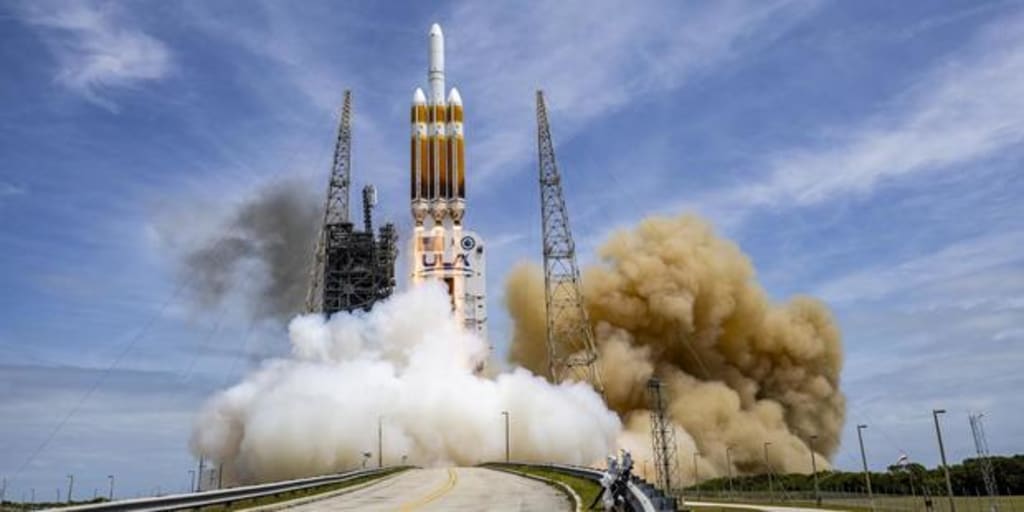Farewell to the Delta 4 Heavy: A Legacy of Innovation in U.S. Rocketry"
Reflecting on Six Decades of Service and Transitioning to the Next Chapter with Vulcan Rockets

In a poignant moment marking the end of an era in U.S. rocketry, United Launch Alliance (ULA) bid adieu to its venerable Delta 4 Heavy rocket with its 16th and final launch. This historic event, which occurred on Tuesday, saw the rocket lifting off from pad 37 at the Cape Canaveral Space Force Station in Florida, carrying a classified spy satellite into orbit. It signified the closure of a storied lineage that has played a pivotal role in shaping the nation's space endeavors since the dawn of the space age.
The Delta 4 Heavy's three hydrogen-fueled RS-68A first stage engines roared to life at 12:53 p.m. EDT, propelling the towering 235-foot-tall rocket skyward with a rush of bright orange flame. Despite encountering a 12-day delay, primarily due to maintenance work on a nitrogen gas supply system, the launch proceeded smoothly without any issues.
Atop the rocket was a classified satellite provided by the National Reconnaissance Office (NRO), the clandestine government agency responsible for managing the nation's fleet of advanced reconnaissance and surveillance assets. Although details about the payload, designated NROL-70, remained closely guarded, the NRO confirmed the mission's success approximately six hours post-launch, indicating the satellite had reached its intended orbit.
NRO Director Chris Scolese emphasized the mission's significance for national security, underscoring its role in furnishing crucial intelligence to policymakers, military personnel, and other stakeholders. While specifics regarding the satellite's capabilities remained undisclosed, expert analysis suggested it likely constituted an advanced signals intelligence satellite destined for a geosynchronous orbit 22,300 miles above the equator. Such satellites, with their stationary positioning relative to Earth, enable continuous surveillance of specific regions, utilizing sophisticated antenna arrays to intercept and analyze radio emissions, particularly of military significance.
The final launch of the Delta 4 Heavy, 63 years after the maiden flight of its predecessor variant, marked an emotional milestone for the managers, engineers, and technicians involved in its assembly and operation. Col. Eric Zarybnisky, director of NRO's Office of Space Launch, reflected on his tenure, having been part of the team that initiated the Delta 4's service to the NRO. Similarly, Tory Bruno, president and CEO of ULA, expressed mixed emotions, acknowledging the bittersweet transition from the Delta lineage to the next-generation Vulcan rockets.
Bruno highlighted the significance of the moment, recognizing the pivotal role the Delta family has played in advancing the nation's space capabilities over the past six decades. While ULA looks toward the future with the Vulcan rocket, Bruno expressed a sense of pride in the Delta's storied legacy and expressed personal sadness at bidding it farewell.
The Delta family of rockets, deeply entrenched in the nation's space program, traces its origins to the early space endeavors, serving in various capacities from intermediate-range ballistic missiles to launching military, NASA, and civilian payloads into orbit. The now-retired Delta 2, for instance, played a crucial role in deploying the first Global Positioning System satellites and supporting numerous planetary exploration missions.
The Delta 4, introduced in 2002, has been a workhorse for the nation's space endeavors, with its Heavy variant capable of deploying high-priority military payloads into complex orbits. However, with the evolving landscape of space exploration characterized by smaller, more numerous satellites and cost-effective alternatives such as SpaceX's offerings, the program's sustainability came into question.
As ULA transitions to the Vulcan rocket, heralded as a less expensive and higher-performance alternative, the curtain falls on the Delta era. While the future holds promise, the legacy of the Delta family remains indelibly etched in the annals of space exploration, symbolizing a testament to decades of innovation, dedication, and service to the nation's space ambitions.





Comments
There are no comments for this story
Be the first to respond and start the conversation.